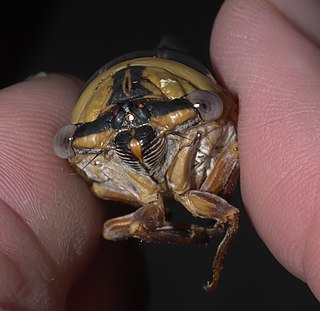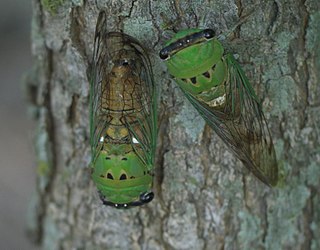
Cicadas of the genus Neotibicen are large-bodied insects of the family Cicadidae that appear in summer or early fall in eastern North America. Common names include cicada, harvestfly, jar fly, and the misnomer locust. Until recently, these species were all in the genus Tibicen, which was redefined in the twenty-first century to include only a few European species, while species from the Western United States and Mexico are now placed in a separate genus, Hadoa. In addition, several former Neotibicen species have been moved to the genus Megatibicen.

Neotibicen tibicen, known generally as the swamp cicada or morning cicada, is a species of cicada in the family Cicadidae. It is widespread across much of the eastern and central United States and portions of southeastern Canada. There are two subspecies, N. tibicen tibicen and N. tibicen australis, with the latter replacing subspecies tibicen in portions of Florida, Georgia, and Alabama.

Cacama is a genus of cactus dodgers in the family Cicadidae. There are about 12 described species in Cacama.

Megatibicen dorsatus, known generally as the bush cicada or giant grassland cicada, is a species of cicada in the family Cicadidae.

Megatibicen is a genus of cicadas in the family Cicadidae, with about 10 described species. The species formerly of genera Ameritibicen Lee, 2016 and Gigatibicen Lee, 2016 are now considered species of Megatibicen Sanborn & Heath, 2016.

Megatibicen pronotalis, or Walker's cicada, is a species of cicada in the family Cicadidae. It is found in the northern Great Plains of the United States.

Megatibicen tremulus, known generally as the western bush cicada or Cole's bush cicada, is a species of cicada in the family Cicadidae. It is found in the Great Plains of the United States, often associated with Sagebrush.

Neotibicen lyricen, the lyric cicada, is a species of cicada in the family Cicadidae.

Neotibicen pruinosus, the scissor grinder, is a species of cicada in the family Cicadidae.

Neotibicen superbus, the superb dog-day cicada, is a species of cicada in the family Cicadidae.
Daza is a genus of cicadas in the family Cicadidae. There are at least two described species in Daza.

Dazini is a tribe of cicadas in the family Cicadidae. There are at least four genera and about eight described species in Dazini.
Herrera is a genus of cicadas in the family Cicadidae. There are about seven described species in Herrera.
Miranha is a genus of cicadas in the family Cicadidae. There is at least one described species in Miranha, M. imbellis.
Ollanta is a genus of cicadas in the family Cicadidae. There are at least four described species in Ollanta.

Neocicada is a genus of cicadas in the family Cicadidae, with about five described species.
Arenopsaltriini is a tribe of cicadas in the family Cicadidae, found in Australia. There are at least two genera and about seven described species in Arenopsaltriini.
Jassopsaltria is a genus of cicadas in the family Cicadidae, found in Australia. There is at least one described species in Jassopsaltria, J. rufifacies.

Macrotristriini is a tribe of cicadas in the family Cicadidae. There are at least 2 genera and 20 described species in Macrotristriini, all found in Australia.
Oncotympanini is a tribe of cicadas in the family Cicadidae, found in China and southeast Asia. There are at least 3 genera and about 12 described species in Oncotympanini.












